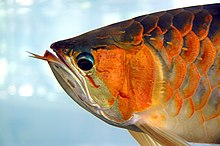| Asian arowana | |
|---|---|

| |
| Super red arowana | |
| Scientific classification | |
| Domain: | Eukaryota |
| Kingdom: | Animalia |
| Phylum: | Chordata |
| Class: | Actinopterygii |
| Order: | Osteoglossiformes |
| Family: | Osteoglossidae |
| Genus: | Scleropages |
| Species: | S. formosus
|
| Binomial name | |
| Scleropages formosus (Sa. Müller & Schlegel, 1844)
| |

| |
| The former primary range of the Asian arowana. The species is now extirpated from much of its former range. | |
| Synonyms | |
| |
The Asian arowana (Scleropages formosus) comprises several phenotypic varieties of freshwater fish distributed geographically across Southeast Asia.[3] While most consider the different varieties to belong to a single species,[4][5][6][3][7] work by Pouyaud et al. (2003)[8] differentiates these varieties into multiple species. They have several other common names, including Asian bonytongue, dragonfish, and a number of names specific to the different color varieties.
Native to Southeast Asia, Asian arowanas inhabit blackwater rivers, slow-moving waters flowing through forested swamps and wetlands. Adults feed on other fish, while juveniles feed on insects.[9]
These popular aquarium fish have special cultural significance in areas influenced by Chinese culture. The name 'dragonfish' stems from their resemblance to the Chinese dragon. This popularity has had both positive and negative effects on their status as endangered species.
- ^ Larson, H.; Vidthayanon, C. (2019). "Scleropages formosus". IUCN Red List of Threatened Species. 2019: e.T152320185A89797267. doi:10.2305/IUCN.UK.2019-3.RLTS.T152320185A89797267.en. Retrieved 12 November 2021.
- ^ "Appendices | CITES". cites.org. Retrieved 2022-01-14.
- ^ a b Mu, Xi-dong; Hong-mei Song; Xue-jie Wang; Ye-xin Yang; Du Luo; Gand-en Gu; Jian-ren Luo; Yin-chang Hu (2012). "Genetic variability of the Asian arowana, Scleropages formosus, based on mitochondrial DNA genes". Biochemical Systematics and Ecology. 44: 141–148. doi:10.1016/j.bse.2012.04.017.
- ^ Yue, Genhua; Li, Yang; Chen, Fan; Cho, Serena; Lim, Lian Chuan; Orban, Laszlo (2002). "Comparison of three DNA marker systems for assessing genetic diversity in Asian arowana (Scleropages formosus)". Electrophoresis. 23 (7–8): 1025–1032. doi:10.1002/1522-2683(200204)23:7/8<1025::AID-ELPS1025>3.0.CO;2-Y. PMID 11981849. S2CID 32510100.
- ^ Hua Yue, Gen; Li, Yang; Lim, Lian Chuan; Orban, Laszlo (2004). "Monitoring the genetic diversity of three Asian arowana (Scleropages formosus) captive stocks using AFLP and microsatellites". Aquaculture. 237 (1–4): 89–102. doi:10.1016/j.aquaculture.2004.04.003.
- ^ Kottelat, M.; E. Widjanarti (2005). "The fishes of Danau Sentarum National Park and the Kapuas Lakes Area, Kalimantan Barat, Indonesia". The Raffles Bulletin of Zoology: 139–173. Archived from the original on 2013-10-20. Retrieved 2013-04-21.
- ^ Mohd-Shamsudin, Maizatul Izzah; Fard, Maryam Zahedi; Mather, Peter B.; Suleiman, Zaini; Hassan, Rosly; Othman, Rofina Yasmin; Bhassu, Subha (2011). "Molecular characterization of relatedness among colour variants of Asian Arowana (Scleropages formosus)". Gene. 490 (1–2): 47–53. doi:10.1016/j.gene.2011.08.025. PMID 21945689.
- ^ Pouyaud, L.; Sudarto, Guy G. Teugels (2003). "The different colour varieties of the Asian arowana Scleropages formosus (Osteoglossidae) are distinct species: morphologic and genetic evidences". Cybium. 27 (4): 287–305.
- ^ "Fishbase - Scleropages formosus food items".
